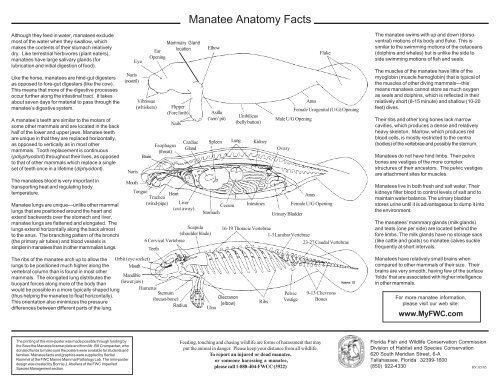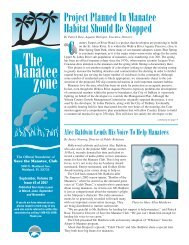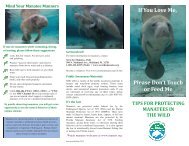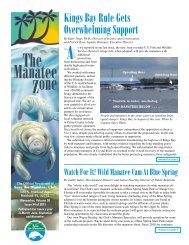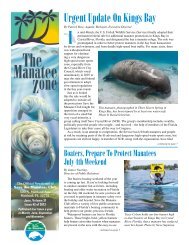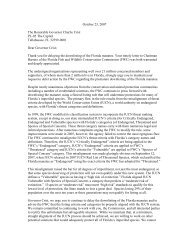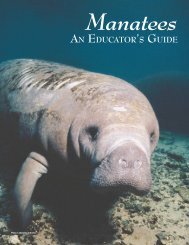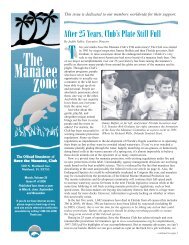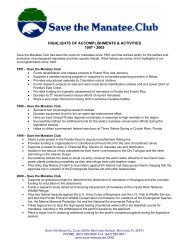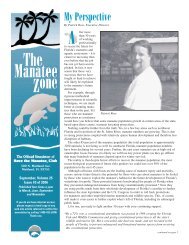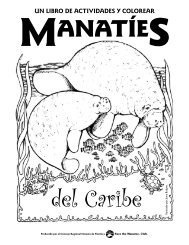You also want an ePaper? Increase the reach of your titles
YUMPU automatically turns print PDFs into web optimized ePapers that Google loves.
<strong>Manatee</strong> <strong>Anatomy</strong> FactsAlthough <strong>the</strong>y feed in water, manatees excludemost of <strong>the</strong> water when <strong>the</strong>y swallow, whichmakes <strong>the</strong> contents of <strong>the</strong>ir stomach relativelydry. Like terrestrial herbivores (plant eaters),manatees have large salivary glands (forlubrication and initial digestion of food).Like <strong>the</strong> horse, manatees are hind-gut digestersas opposed to fore-gut digesters (like <strong>the</strong> cow).This means that more of <strong>the</strong> digestive processesoccur fur<strong>the</strong>r along <strong>the</strong> intestinal tract. It takesabout seven days for material to pass through <strong>the</strong>manatee’s digestive system.A manatee’s teeth are similar to <strong>the</strong> molars ofsome o<strong>the</strong>r mammals and are located in <strong>the</strong> backhalf of <strong>the</strong> lower and upper jaws. <strong>Manatee</strong> teethare unique in that <strong>the</strong>y are replaced horizontally,as opposed to vertically as in most o<strong>the</strong>rmammals. Tooth replacement is continuous(polyphyodont) throughout <strong>the</strong>ir lives, as opposedto that of o<strong>the</strong>r mammals which replace a singleset of teeth once in a lifetime (diphyodont).The manatees blood is very important intransporting heat and regulating bodytemperature.<strong>Manatee</strong> lungs are unique—unlike o<strong>the</strong>r mammallungs that are positioned around <strong>the</strong> heart andextend backwards over <strong>the</strong> stomach and liver,manatee lungs are flattened and elongated. Thelungs extend horizontally along <strong>the</strong> back almostto <strong>the</strong> anus. The branching pattern of <strong>the</strong> bronchi(<strong>the</strong> primary air tubes) and blood vessels issimpler in manatees than in o<strong>the</strong>r mammalian lungs.Naris(nostril)NarisMouthEyeVibrissae(whiskers)BrainEarOpeningFlipper(Fore limb)NailsEsophagus(throat)TongueTrachea(wind-pipe)TeethMammary GlandlocationHeartCardiacGlandLiver(cut away)Scapula(shoulder blade)6 Cervical VertebraeElbowAxilla(‘arm’ pit)Umbilicus(belly button)Spleen Lung KidneyCecumStomachIntestinesFlukeAnusFemale Urogenital (U/G) OpeningMale U/G OpeningOvaryUrinary BladderAnusFemale U/G Opening16-19 Thoracic Vertebrae1-3 Lumbar Vertebrae23-27 Caudal VertebraeThe manatee swims with up and down (dorsoventral)motions of its body and fluke. This issimilar to <strong>the</strong> swimming motions of <strong>the</strong> cetaceans(dolphins and whales) but is unlike <strong>the</strong> side toside swimming motions of fish and seals.The muscles of <strong>the</strong> manatee have little of <strong>the</strong>myoglobin (muscle hemoglobin) that is typical of<strong>the</strong> muscles of o<strong>the</strong>r diving mammals—thismeans manatees cannot store as much oxygenas seals and dolphins, which is reflected in <strong>the</strong>irrelatively short (8-15 minute) and shallow (10-20feet) dives.Their ribs and o<strong>the</strong>r long bones lack marrowcavities, which produces a dense and relativelyheavy skeleton. Marrow, which produces redblood cells, is mostly restricted to <strong>the</strong> centra(bodies) of <strong>the</strong> vertebrae and possibly <strong>the</strong> sternum.<strong>Manatee</strong>s do not have hind limbs. Their pelvicbones are vestiges of <strong>the</strong> more complexstructures of <strong>the</strong>ir ancestors. The pelvic vestigesare attachment sites for muscles.<strong>Manatee</strong>s live in both fresh and salt water. Theirkidneys filter blood to control levels of salt and tomaintain water balance. The urinary bladderstores urine until it is advantageous to dump it into<strong>the</strong> environment.The manatees’ mammary glands (milk glands)and teats (one per side) are located behind <strong>the</strong>fore limbs. The milk glands have no storage sacs(like cattle and goats) so manatee calves sucklefrequently at short intervals.The ribs of <strong>the</strong> manatee arch up to allow <strong>the</strong> Orbit (eye socket)lungs to be positioned much higher along <strong>the</strong> Mouthvertebral column than is found in most o<strong>the</strong>rmammals. The elongated lung distributes <strong>the</strong>Mandiblebuoyant forces along more of <strong>the</strong> body than(lower jaw)would be possible in a more typically shaped lung HumerusSternum(thus helping <strong>the</strong> manatee to float horizontally).(breast-bone)This orientation also minimizes <strong>the</strong> pressuredifferences between different parts of <strong>the</strong> lung.RadiusUlnaOlecranon(elbow)RibsPelvicVestige9-13 ChevronsBones<strong>Manatee</strong>s have relatively small brains whencompared to o<strong>the</strong>r mammals of <strong>the</strong>ir size. Theirbrains are very smooth, having few of <strong>the</strong> surface‘folds’ that are associated with higher intelligencein o<strong>the</strong>r mammals.For more manatee information,please visit our web site:www.MyFWC.comThe printing of this mini-poster was made possible through funding by<strong>the</strong> <strong>Save</strong> <strong>the</strong> <strong>Manatee</strong> license plate and from Mr. Bill Crumpacker, whodonated funds to make sure <strong>the</strong> posters were available for students andfamilies. <strong>Manatee</strong> facts and graphics were supplied by SentielRommel of <strong>the</strong> FWC Marine Mammal Pathology Lab. The mini-posterdesign was created by Bonnie J. Abellera of <strong>the</strong> FWC ImperiledSpecies Management section.Feeding, touching and chasing wildlife are forms of harassment that mayput <strong>the</strong> animal in danger. Please keep your distance from all wildlife.To report an injured or dead manatee,or someone harassing a manatee,please call 1-888-404-FWCC (3922)Florida Fish and Wildlife Conservation CommissionDivision of Habitat and Species Conservation620 South Meridian Street, 6-ATallahassee, Florida 32399-1600(850) 922-4330RV: 05/05


